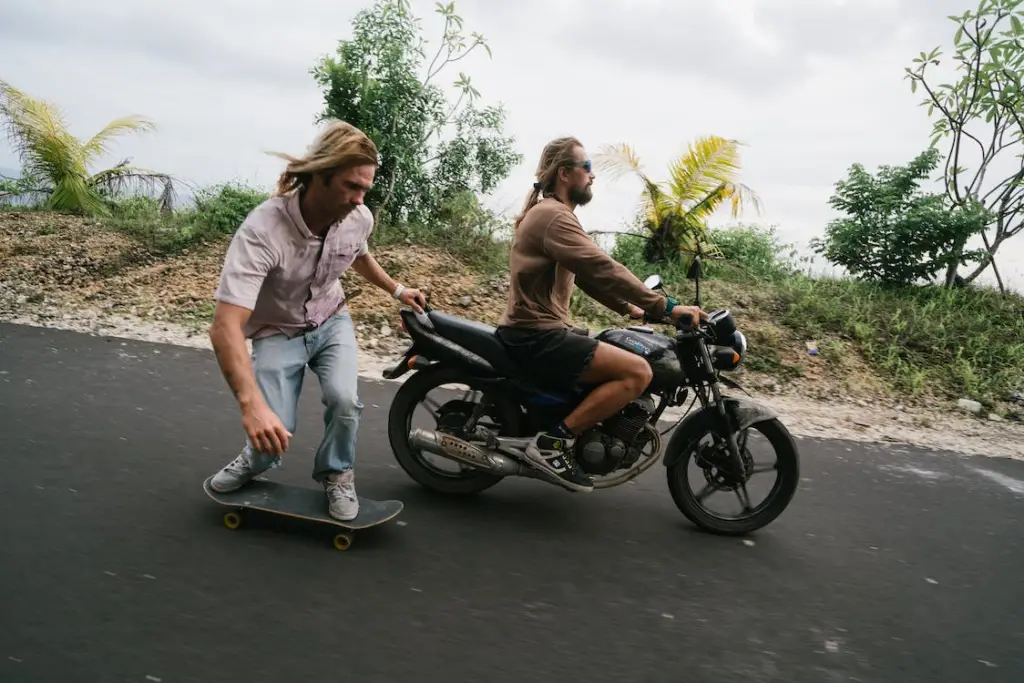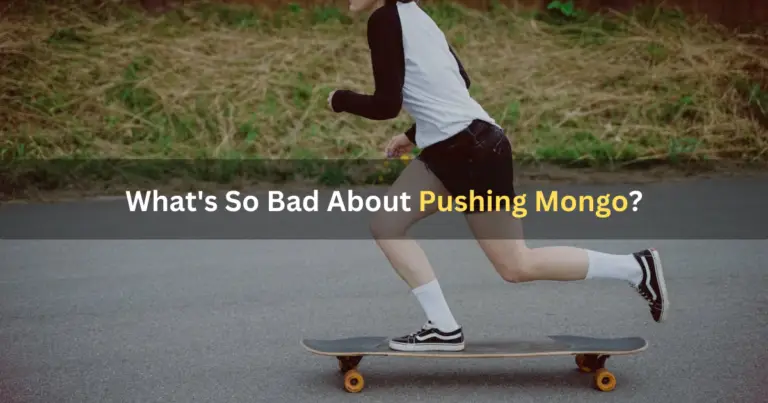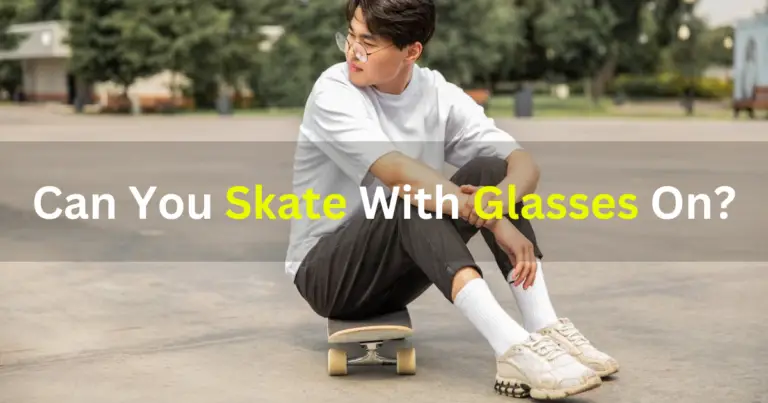
Almost every skateboarder has considered going for a ride at least once but ultimately decided against it. Skitching was initially introduced in video games, where I could skate and then “hang” from the car’s body to increase my speed. As I became older, I realized I couldn’t longer ignore the impulse.
Skitching is very risky. Hence no one should do it. You risk making a stranger upset if you cling to their vehicle. My first time doing it, I hung on to a friend’s automobile and made a spectacle of myself.
Skitching is foolish and dangerous, but here are some pointers if you insist on doing it. Don’t bother with other people; borrow a friend’s automobile.
What is skateboard Skitching?
Skateboard skitching is when you’re on a skateboard and grabbing onto a car to move forward. The person skitching is not in the vehicle but is holding on to the back or side.
Skitching is like hitching but with fewer people. Skitchers can use many different kinds of transportation, like bicycles or snow. Skitching is much like attaching, but you do it on a skateboard or roller skates instead of a bike.
Skitching can cause serious accidents, so keep that in mind. For instance, if you hold on to a car and the driver looks back and sees you, he might become sidetracked and cause an accident. He could also do something to make you fall off your skateboard.
Most skitching happens in cities, where there are more people and cars. Since there is more traffic, the car stops more often, giving you more chances to get on. Also, the vehicles don’t go too fast, making you less likely to get hurt.
When you skitch on a motorbike, you hold on to one side and drag your feet along the ground.
Snow skitching is when you hold on to the back of a car and slide on your feet. It used to be more popular. Kids would cling to the back of the school bus during snowy conditions. Because the roads were slick, the bus didn’t go very fast, and you could slide on your feet.
Is it hard to skitter?

When you look at someone skitching or try to picture yourself doing it, it seems easy but very hard. It’s like riding an electric skateboard the first time, except you can pull yourself from the front. If the car stops when you’re not ready, it’s easy to fall, so you should always be prepared for it.
Skitching is a relatively easy move on a skateboard, and anyone who knows the basics can do it, but there is little room for mistakes. Also, because errors have much worse effects, it can be scary to ride, which makes skitching much harder.
You’ll be fine if you don’t wait and remember to get ready for the car to stop. But if you skitch on a random vehicle, someone may break or drive strangely because your friends will think you are behind the vehicle. Still, this isn’t something a stranger who doesn’t know would do.
The driver will likely get mad if he sees you skitching in his car, so you must learn to do it while staying out of sight.
Use safety gear at all times
Skateboarding is already dangerous, so wear protective gear if you want to go.
1. Protective caps
A hat is the most essential piece of safety gear. Most of the time, you hold on to the body. If you hold on to a door, you might fall and hit your head on the car. If you’re unlucky, your charge can get run over, so always wear a helmet.
2. Guards for the wrists
Protecting yourself from twists can save you a lot of grief. For example, you usually don’t have much time to respond if you fall while hanging on to a car. When you lose, the most common thing you do is catch yourself with your hands.
If you hurt your arms, you can break them for the rest of your life, so take care of them if you want to skitch.
3. Protecting the Elbow
If you fall while skitching, you’ll probably start to roll or hit your side, so elbow protection is essential to keep you from getting hurt badly.
If you fall, you’re most likely to hit your knees, so it’s a good idea to cover them if you can.
How to do a skateboard skitch?

No one should try skitching. It can cause significant accidents; you might get them in trouble if you do it with random cars.
Since people rarely engage in skitching, it can take a lot of work to get good at it. Getting help from a friend with a car will make it much more manageable.
When you’re holding onto a moving car, the most important thing to remember is that they also stop. You can easily fall off a moving vehicle if you aren’t ready for it to stop.
1. Bumper to bumper
Bumper hanging is the most popular way to skitch. This is when you hold on to the car’s bumper. This is the most common choice because it prevents you from getting caught in this manner.
2. Hitching the door
You can also skitch while hanging onto the side of the car. People usually do it when they are about to get out of the vehicle or holding onto a friend’s car. When you stand on the car’s side, keeping your balance and holding on to it is easier. Do this when you can.
Is skitching against the law?

Almost every skater has seen skitching on TV, in movies, or real life, but is it legal? It’s dangerous, but are there more risks than injuries?
1. When you can do it
You can skitch in many places worldwide, but you must be careful around cars because of the law. Still, you would win if you went to court.
You won’t face penalties for getting caught skipping unless it results in an accident.
2. When breaking the law
Most laws say you can’t touch a moving car. You won’t get in trouble but could get a too-high fine.
Risks of skitching

1- The Host of the Skittering: The Car
Modern cars and trucks have a lot of places where you can grab a hold and skitch. These include wheel wells, roof racks, spare tire racks, tail lights, door handles, and towbars. There is no evidence that these handholds make skitching easier or let you stay in touch with the host car longer.
Even though trucks have multiple handholds, Many consider them the optimal choice for novice stitchers.
This is a worry because the workers who drive these vehicles aren’t likely to notice the sketcher because of the demands of the job, the blind spots of the car, and the fact that the car is much heavier.
Look at and redesign the handholds to ensure they continue serving the driver and their tasks while making it more challenging for jumpers to grasp.
The sketcher moves at the same speed as the car, so accidents or death can happen even at low speeds (20 mph).
Another possible danger that is challenging to spot is the drag force that builds up around the car, especially around the tires. This creates a sucking effect similar to what happens when skateboarding downhill.
It is uncertain whether this drag effect is directly responsible for the high number of skitchers falling and getting run over by the car they are leaping off.
Skitchers can reduce the effect of drag by standing behind the car. However, this raises a different set of safety concerns, such as a lack of vision and the failure to predict and prepare for changes in speed and direction.
2- Is the Skittering Host Willing or Unwilling? Do they Know What’s Going on?
Even a slight change in acceleration or direction can only prevent the skitchers from being ready for these adjustments. This is because the driver has a significantly different impression of speed compared to the sketcher, presuming they realize they are there.
Furthermore, drivers’ reactions to the skitcher on their vehicle would vary based on their familiarity with the skitcher.
3- NMRWD, Environment, and Experience in the Skitcher and Agent
Sketchers face significant dangers related to speed, obstacles, surface type, device control, and the risk of being run over by vehicles, similar to the safety concerns that skaters commonly encounter.
The kitchen’s skill and expertise, as well as the kind of gear they’re utilizing, will determine how well they manage rapid acceleration and deceleration. Skateboarders may go faster on longboards because they are more stable at high speeds and have less tendency to wobble.
Varied types of skating activities need diverse levels of protective gear, reflecting an understanding of the skateboard’s versatility and the effect of terrain.
What Can Be Done to Prevent Engagement and the Injuries and Deaths It Causes?

Similar behaviors, such as “scutting” (riding on the back of a moving vehicle) or “car surfing” (standing or depending on the top of a moving motor vehicle), also present a challenge for injury prevention professionals.
This analysis identified many agent, Host, and environmental features that may guide further attempts to reduce skitching-related injuries.
1- Strategies for Preventing Injuries: The Hierarchy of Risk Elimination via Law, Policy, and Prohibition
Skirting is illegal in Australia and in several US states. The proposal suggests educating sketchers about the illegality of their actions as their presence becomes more noticeable. There is a significant gap between outlawing an effort and actively enforcing and explaining the prohibition.
2- Replacement — Enhancing SkatePark Architecture
While people use many other recreational devices for skitching, this research focuses primarily on skateboards due to their association with severe injuries and deaths.
Although skipping by bicycle is more widespread, the risks of severe or fatal injury reduce because of the increased speed and durability of bikes. Skateboards are less forgiving than bicycles if you lose footing due to their inherent instability.
Somebody might lower Skitching participation, encouraging skateboard usage at speeds at which e lower they can practically utilize and by enhancing the usefulness and availability of skating infrastructure.
Skate parks are beneficial for skaters, parents, and the community as a whole because they provide a place where somebody in skateboarding can be in a safe environment (i.e., away from motor vehicles), foster skill development when a variety of terrains in the park, encourage physical activity, and are a recreational sport that is less expensive to partake in than other mainstream sports.
Skaters “bored” with the current facilities can dissuade from opportunistic skitching if advocates for additional provision, regular maintenance, or updating/retrofitting of infrastructure are successful.
3- Mechanical Adjustments for Better Control
Only two examples of engineering controls used in the literature are decreasing the number of grips on vehicles and increasing skateboard stability. We must think more to understand how these changes work and their advantages.
Beyond rear under-run barriers, size reduction, and electronic monitoring surrounding the vehicle, there are broader talks about modifications to trucks that may assist in minimizing skitching injuries.
4- Controls at the administrative level, including education and procurement limits
There are two sorts of skitching, one in which the driver is a stranger and is either oblivious of or aware of the sketcher’s presence, and the other in which the driver is a friend, family, or acquaintance of the skitchers.
One way to guarantee drivers are paying attention is to teach them what to do if a sketcher is foining their car and what the legal repercussions would be.
Such awareness programs should stress the need to slow down, with the ultimate goal of coming to a complete stop until the potential skitcher has disengaged and moved on from the vehicle.
Skitchers are likely only to stick around if the automobile they follow speeds up. As the skitcher is unlikely to be in control of the situation, there is a high likelihood that the skitcher will fall and sustain severe injuries if drivers who see the skitcher speed up or begin driving erratically in an attempt to extricate the skitcher.
Authorities give drivers fines, community service, and license suspensions when they connect to a skitcher.
It will be necessary to concentrate on education to reach drivers and young people, especially community service, and license suspensions have all been handed out to drivers young drivers who the papers say voluntarily to support their friends’ skitching.
Co-occurring with the installation or renovation of skate parks could be providing coaching clinics/training where skaters can learn the unspoken social rules, etiquette, and general skills associated with recreational devices, such as controlling the device and how to fall.
As the prevalence of video game depictions of skitching grows, it becomes clearer that restricting access to these games by vulnerable youth by altering their classification might be an effective strategy.
The media may also step in the right direction by rethinking how they cover skitching.
Omitting specifics in a particular manner makes it less likely for skitching to spread that does not risk glorification. Reducing injuries is possible if media efforts.
5- Head protection is an essential piece of PPE.
While there is much discussion over whether or not skitchers require helmets by legislation, more is needed about which categories of recreational users fall under these mandates. When appropriately used, bicycle helmets effectively prevent head injuries and their repercussions.
Skitching fatalities mainly occur when skitchers fall from the vehicle, hitting their heads on the pavement below or getting run over by a car, often the one towing them.
However, When a vehicle drives over the skitcher, the helmet is less likely to prevent severe or fatal head injuries. Skateboarding, in particular, needs a shift in attitude toward helmet-wearing. Therefore, increasing helmet use will need some strategies.
Conclusion
Skitching is something people should refrain from trying. There are many ways to skitch, but the one thing they all have in common is that they are dangerous. Suppose you want to do this; at least wear safety gear. Be ready for the car to stop. If you’re not prepared, you’ll fall hard and hurt yourself.
Skateboard Skitching is dangerous for you and the people around you, so consider whether it’s worth it. Most places let you do it, or you will get in trouble after an accident. You will probably get a fine when you do something against the law. How much you pay relies on how much risk you took or if you caused an accident.
FAQs
Q: What are skater girls called?
Betty is the name for the woman who rides on the back of a skateboard and does tricks and stunts. Since the 1960s, when people first used the term, skaters have been linked to it.
Q: How do you turn on a skateboard?
Since our legs are bent nicely. Since our weight is on the balls of our feet, they should be in line with the center of the board.
Q: What do skateboarders call their boards?
Most skaters call their boards or skateboards their boards. There’s no reason to be fancy. When you hear the word “deck,” it means the part of the skateboard made of wood. Someone who calls a skateboard a “wood” or a “ride” sounds like they are trying too hard to sound like a skater.
Video Guide:
Read Also
- What Are Some Daily Uses For A Skateboard? – Skateboarding Beyond Tricks In 2023
- In Skateboarding, What Is Shredding? – Unleashing The Thrills In 2023
- Why Do People Hate Skateboarders? – Unraveling The Reasons In 2023
- How Tight Should Skateboard Wheels Be? – Comprehensive Guide To Achieving Your Desired Ride 2023
- Is Rollerblading Easier Than Skateboarding? -Unraveling The Ease Factor In 2023
- Is Kryptonics A Good Skateboard Brand? – A Closer Look Reputation And Quality In 2023






